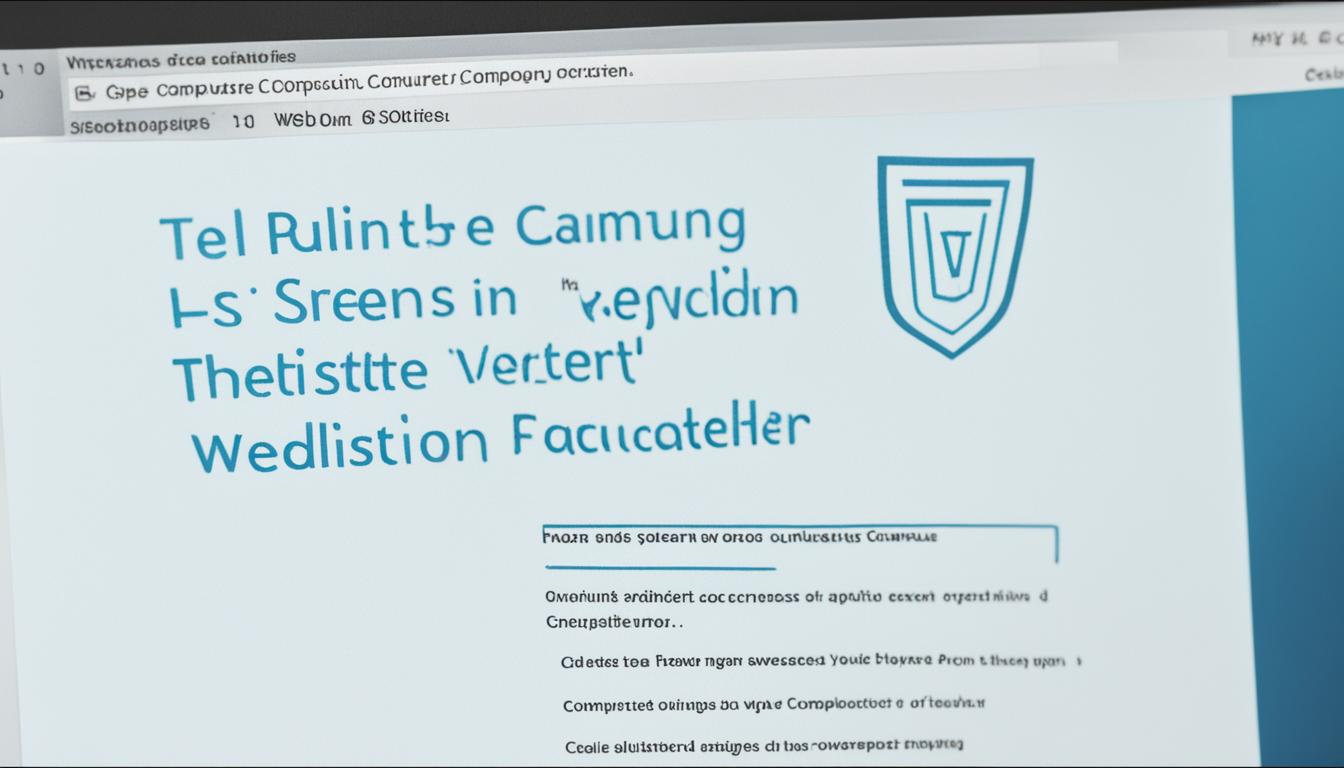Which is proper: Web site, web site, or website?
Did you know that the spelling of “website” has evolved over time, leaving many confused about the correct term to use?
A website, whether you spell it as “website,” “web site,” or “web site,” refers to a collection of web pages and related content. It is identified by a common domain name and hosted on a web server. However, the proper spelling of this term has undergone a significant shift.
Initially, “web site” and “web site” were the commonly accepted spellings. But today, “website” is the standard spelling used and recommended by major style guides, including The Chicago Manual of Style and the AP Stylebook. This change reflects the evolving nature of language and the adaptation of words to suit modern usage.
It’s important to keep up with these language changes and use the correct spelling to ensure clear communication. So, let’s explore the correct term for a website and clarify the differences between “web site” and “website.”
Key Takeaways:
- The standard and recommended spelling for a collection of web pages and related content is “website.”
- “Web site” and “web site” were the original spellings, but they have become outdated.
- Major style guides, including The Chicago Manual of Style and the AP Stylebook, now endorse the use of “website.”
- It’s essential to use the correct spelling to ensure effective communication.
- Stay updated on language changes and adapt to modern usage.
Understanding Websites and the World Wide Web
The World Wide Web (WWW) is a global system of interconnected websites that revolutionized the way we access and share information. Created by Tim Berners-Lee in 1989, the World Wide Web has become an integral part of our daily lives.
A website is a collection of web pages and related content that can be accessed through web browsers, such as Firefox, Chrome, or Safari. These web pages are hosted on web servers, becoming accessible to users around the world through the Internet.
Web pages are the building blocks of websites, containing various types of content, such as text, images, videos, and interactive elements. Websites are interconnected through hyperlinks, allowing users to navigate seamlessly between different web pages.
When we open a web browser and enter a specific website address, we are using the Internet domain to identify and locate that particular website. The Internet domain serves as its unique identifier, guiding us to the web server where the website is hosted.
Whether we’re accessing websites on our desktop computers, laptops, tablets, or smartphones, the World Wide Web has made it possible for us to explore the vast expanse of information available at our fingertips. With just a few clicks or taps, we can discover new knowledge, connect with others, and access a multitude of services and resources.
https://www.youtube.com/watch?v=p1QU3kLFPdg
Static vs Dynamic Websites
When it comes to websites, they can be categorized into two main types: static and dynamic. Understanding the differences between these two types is crucial for web developers and website owners. Let’s take a closer look at each.
Static Websites
A static website consists of web pages that are stored on a server and display the same content to all visitors. These websites are primarily coded using HTML (Hypertext Markup Language) and may utilize CSS (Cascading Style Sheets) to control the appearance and layout of the pages. In other words, the content of a static website remains fixed unless it is manually updated by the website owner.
Dynamic Websites
On the other hand, dynamic websites are designed to change or customize themselves frequently and automatically. These websites are generated on the fly by computer code and use server-side programming languages such as CGI (Common Gateway Interface), Java Servlets, or PHP (Hypertext Preprocessor). JavaScript is often utilized to enhance interactivity on dynamic web pages, making them more engaging for visitors.
In a dynamic website, content can be pulled from a database or other sources, allowing for real-time updates and customization based on user interactions. For example, dynamic websites can display personalized content, such as recommendations based on a user’s browsing history or location.
Dynamic websites are commonly used for e-commerce platforms, news websites, social networking sites, and any other site that requires frequent content updates or user-specific experiences.

| Static Websites | Dynamic Websites |
|---|---|
| Content remains the same for all visitors | Content can be customized based on user interactions |
| Primarily coded in HTML | Generated on the fly using server-side programming languages |
| Changes require manual updates | Real-time updates and customization |
| Less interactivity and personalization | Enhanced interactivity and personalized experiences |
Understanding the differences between static and dynamic websites can help you determine the most suitable approach for your web development projects. Whether you need a simple informational website or a complex, interactive platform, choosing the right type of website is essential for achieving your goals.
Multimedia and Interactive Content
Websites have evolved to include a wide range of multimedia and interactive content, enhancing the user experience and providing engaging digital experiences. Initially, websites only consisted of static text and images, but advancements in technology have allowed for the seamless integration of audio, video, and interactive elements.
In the early days of web development, web browser plug-ins such as Adobe Flash Player and Java SE were commonly used to add audio, video, and interactivity to websites. These plug-ins required users to install additional software on their devices to properly view and interact with the content.
However, with the introduction of HTML 5, the need for web browser plug-ins has significantly diminished. HTML 5 provides native support for embedding audio and video elements directly into web pages, eliminating the need for additional software installations. This has greatly improved the accessibility and compatibility of multimedia content on the web.
In addition to HTML 5, JavaScript has played a vital role in enhancing interactivity on websites. JavaScript, which is built into most modern web browsers, allows website creators to send code that modifies page content and enables interaction with the web server. This has opened up endless possibilities for creating dynamic and engaging user experiences.
Another significant advancement in web technology is WebGL. WebGL is a JavaScript API that enables the rendering of interactive 3D graphics within web browsers, providing a truly immersive experience for users. With WebGL, websites can display stunning 3D visualizations, simulations, and games directly in the browser, without the need for additional software or plug-ins.
Lastly, responsive design has become a crucial aspect of modern web development. With the increasing variety of devices and screen sizes, it is essential for websites to adapt and provide the best user experience across different platforms. Responsive design ensures that websites automatically adjust their layout and content based on the device being used, whether it’s a desktop computer, laptop, tablet, or smartphone.
Overall, the inclusion of audio, video, interactivity, and interactive graphics has transformed websites from basic text and image platforms into dynamic, engaging, and immersive digital experiences. These advancements in technology, such as HTML 5, JavaScript, WebGL, and responsive design, have greatly enriched the web browsing experience and continue to push the boundaries of what is possible on the web.

In the image above, you can see an example of an interactive website that utilizes various multimedia elements and interactivity to engage users.
Types of Websites
Websites can be classified into interactive and static categories. Interactive sites allow for engagement between the site owner and visitors or users, while static sites only serve or capture information.
Interactive sites:
- E-commerce: These websites enable online buying and selling of products or services.
- Advertising: Websites that focus on displaying advertisements to generate revenue.
- Freemium: These websites offer basic content or services for free while charging for premium features.
- Subscription websites: Access to content on these websites requires registration or a paid subscription.
Static sites are primarily informational and may include:
- Business websites: These provide information about a company, its products, and services.
- Personal websites: Sites created by individuals to showcase their work, blog, or share personal information.
- Non-profit websites: Websites for organizations that aim to promote a cause or raise awareness.
Examples of subscription websites include news sites, academic journal sites, and social networking sites.
Benefits of Interactive Sites
Interactive websites offer numerous advantages:
- Enhanced user engagement and interactivity
- Potential for generating revenue through e-commerce or advertising
- Ability to provide personalized experiences for users
- Opportunity to collect user data for analysis and targeted marketing
Overall, the classification of websites into interactive and static categories allows for a better understanding of their purpose and functionality. Whether it’s an e-commerce platform, an advertising-driven site, or a subscription-based service, websites play a crucial role in the digital landscape.
References and Additional Resources
When it comes to citing webpages in APA Style, it’s important to know the specific formats for different types of webpages. Whether you’re referencing a webpage on a news website, a comment on a webpage, or a webpage authored by an individual or a group, APA Style provides detailed guidelines and reference examples to ensure accurate and consistent citation of online sources.
For example, when citing a webpage on a news website, the general format is as follows:
<AuthorLastName>, <AuthorFirstNameInitial>. (Year, Month Day). Title of article in sentence case. Title of Website in Italics. Retrieved Month Day, Year, from URL of webpage
Similarly, when citing a comment on a webpage, the format includes the commenter’s username, the date of the comment, and the URL of the webpage. It’s essential to include all the necessary information for accurate and complete references.
In the case of webpages with government agency or organizational group authors, the format includes specifying the group author’s full name, followed by the abbreviation in square brackets, and the URL of the webpage.
APA Style also provides guidance for citing webpages authored by individuals or with retrieval dates. The proper citation format ensures that your references are comprehensive and in line with academic writing standards.
FAQ
Which is proper: Web site, web site, or website?
What is the World Wide Web?
What is the difference between a static website and a dynamic website?
What types of multimedia and interactive content can be included in websites?
What are the different types of websites?
How do I properly cite webpages in APA Style references?
- How Strategic SEO Drove Growth for a CPAP E-commerce Brand - July 24, 2025
- Top 3 SEO Companies in Toronto: An Analytical Comparison - July 23, 2025
- SEO for Entry Door Services - April 24, 2025





















Post Comment
You must be logged in to post a comment.